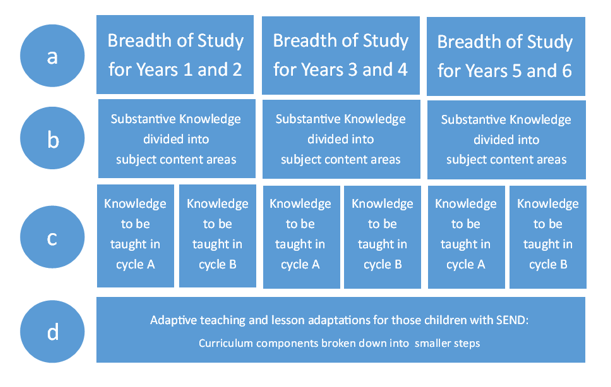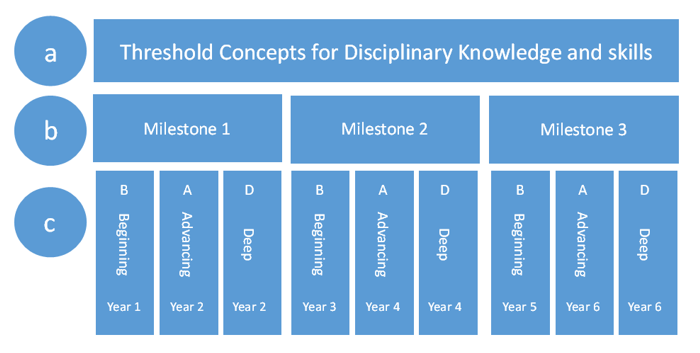Curriculum Design Statement
Below is our Curriculum Design Statement relating to how we are meeting the National Curriculum requirements within Key Stages 1 and 2 as well as how we tailor our Curriculum to the needs of our school community. For more information about our Early years curriculum please see the Early Years Curriculum Design page.
Intent
The breadth of our curriculum is designed with three goals in mind:
- To give pupils appropriate experiences to develop as confident, responsible citizens
- To provide rich diverse and engaging opportunities for learning
- To provide a coherent, structured, academic curriculum that leads to sustained mastery and a greater depth of understanding for those who are capable
1. Appropriate experiences
We have developed three curriculum drivers that shape our curriculum, bring about the aims and values of our school, and respond to the particular needs of our school community:
Citizenship – which helps our pupils to be an active, responsible member of our school, the locality, our country and the world
Ambition – which help pupils to build aspirations and know available possibilities for their future lives
Resilience – which helps our pupils to overcome difficulties and use their initiative to solve problems and further their learning
2. Opportunities for Learning
We incorporate a range of varied learning opportunities to develop children’s interest and engagement including experiences beyond the National Curriculum expectations. Lessons focus on collaborative, enquiry based learning that use a range of teaching and learning approaches.
3. A Coherently planned academic curriculum
Underpinned by the three drivers, our academic curriculum sets out:
a) A clear list of the breath of topics to be covered in order to meet the National Curriculum with key aspects for each subject identified
b) The substantive knowledge and disciplinary skills that pupils should learn, understand and apply
c) Progression within the disciplinary concepts (‘Milestones’) and progression of substantive knowledge over time – the building blocks and sequence of learning for each subject.
The diagram below shows the model of our curriculum structure for substantive knowledge:

The above diagram shows:
a) The curriculum breadth for each year group ensures each teacher has clarity as to what to cover and is drawn from the aims of the National Curriculum and the programmes of study.
b) Substantive knowledge divided into subject content areas are the key areas of knowledge for each curriculum subject. They are chosen to build knowledge over time that is relevant to the curriculum subject and build on prior learning.
c) Knowledge to be taught in each cycle defines the substantive knowledge to be taught in each of the two years in our curriculum cycle and ensures coverage of the National Curriculum programmes of study across each two year phase of school.
d) Adaptive teaching allows for the adaptation of substantive knowledge in order to meet specific needs of children through breaking learning down into smaller steps. We expect all pupils to acquire the planned substantive knowledge in each cycle of the curriculum. However, some children may need smaller steps of knowledge acquisition.

The diagram below is based on the Chris Quigley Essentials curriculum model and shows the model of our curriculum structure for disciplinary skills and concepts.

The above diagram shows:
a) Threshold concepts are the key disciplinary aspects of each subject. They are chosen to build conceptual understanding within subjects and are repeated in each unit of work.
b) Milestones define the standards for the threshold concepts and ensure progression across each two year phase of school.
c) Depth allows for the building of skills and concepts over time. We expect pupils in the first year of the milestone to develop a Basic understanding of the concepts and an Advancing or Deep understanding in the second year of the milestone. The first year in a milestone (Year groups 1, 3 and 5) is the skill building phase that provides the fundamental foundations for later application. Learning at this stage must not be rushed and will involve a high degree of repetition or scaffolding so that procedures, concepts and skills enter pupils’ long-term memory.
Capability
The curriculum sets high expectations for all children. However, for some pupils with high levels of special educational needs or disabilities, a more personal approach to the curriculum is designed. This is done on an individual basis that targets children personal targets, needs and next steps for learning.
Specific Subject Intent
Subject specific detail about curriculum intent and implementation can be found on the curriculum progression document for each individual subject.
Implementation
Our curriculum is subject specific to enable precision around the knowledge, skills and concepts that are taught over time. Our curriculum design is based on evidence from cognitive science; two main principles underpin it:
1) Learning of both knowledge and disciplinary skills and concepts is most effective with repetition
2) Retrieval of previously learned substantive knowledge and disciplinary concepts and skills is frequent and regular, which increases both storage and retrieval strength.
In addition, we also understand that deep learning is invisible in the short-term and embedding knowledge takes time. However, these processes are supported through the lesson structure with exit tasks/quizzes completing the learning process within a lesson and retrieval tasks forming the start of the next lesson. Retrieval practices and tasks also take place over time to revisit and embed key learning into long term memory – these are termed ‘Flashbacks’. Links between lessons, subjects and real life experiences also underpinned the embedding of knowledge, skills and concepts.
Curriculum progression documents for each individual subject detail fully the implementation of specific subjects, including the use of any published schemes, specific teaching strategies and essential classroom practices related to each subject.
Assessment
Nothing is learned unless it rests in pupils’ long-term memories. This does not happen, and cannot be assessed, in the short term. Assessment, therefore answers two main questions:
How well are pupils coping with the curriculum content?
How well are they retaining previously taught content?
Assessment within lessons and over time feeds into the sequence of lessons to ensure that children are coping with the curriculum content and retaining previously taught content. Adaptations, re-teaching and interventions are all used to ensure that learning of substantive knowledge is developed and that disciplinary skills and concepts are advanced. Curriculum review feeds in to this process with evaluation over time informing future curriculum changes.
Impact
The impact of our curriculum is that by the end of each Milestone, the vast majority of pupils have mastery of the content, that is, they remember it all and are fluent in it; some pupils have a greater depth of understanding. We assess children’s acquisition of the identified knowledge, skills and concepts through in lesson assessment/observations (assessment for learning), exit tasks or quizzes and assessment tasks at the end of a unit of work. All of these assessments feed in to teacher assessment judgements throughout the year and the summative assessment judgement at the end of the academic year. Children’s development is monitored carefully to ensure they are on track to reach the expectations of our curriculum.
